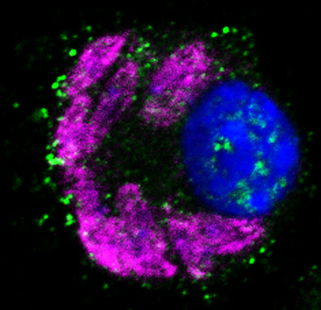How tumour necrosis factor protects against infection

Macrophages (blue nucleus) that are infected with Leishmania major (purple) and have been stimulated with the messenger substance interleukin 4 produce arginase 1 (green). Katrin Paduch/FAU Institute of Microbiology
In order to defend the body against intracellular pathogens, such as the single-cell parasites Leishmania major, nitric oxide (NO) must be produced. This is formed in macrophages and other phagocytes through type 2 NO synthase (NOS2).
However, the function of NOS2 is inhibited by a competing enzyme called arginase 1. The researchers, led by PD Dr. Ulrike Schleicher and Prof. Dr. Christian Bogdan at FAU’s Institute of Microbiology – Clinical Microbiology, Immunology and Hygiene, demonstrated through cell culture experiments and an infection model that tumour necrosis factor inhibits arginase 1 synthesis, which depends on the messenger substance interleukin 4. This causes nitric oxide production to increase and suppresses the pathogens.
‘As long as they can be confirmed in ongoing experiments with human cells, these findings provide a plausible explanation of the increased susceptibility to infection that occurs during anti-TNF treatments,’ explains Professor Bogdan, ‘In the future, concurrent use of arginase 1 inhibitors could minimise the risk of infection associated with TNF inhibition.’
The results of the study, which was partially carried out in the framework of FAU’s Interdisciplinary Centre for Clinical Research and DFG Collaborative Research Centre 1181, have recently been published in the international journal Cell Reports (DOI: 10.1016/j.celrep.2016.04.001)
Further information:
Prof. Dr. Christian Bogdan
Phone: +49 9131 8522551
christian.bogdan@uk-erlangen.de
Media Contact
More Information:
http://www.fau.de/All latest news from the category: Life Sciences and Chemistry
Articles and reports from the Life Sciences and chemistry area deal with applied and basic research into modern biology, chemistry and human medicine.
Valuable information can be found on a range of life sciences fields including bacteriology, biochemistry, bionics, bioinformatics, biophysics, biotechnology, genetics, geobotany, human biology, marine biology, microbiology, molecular biology, cellular biology, zoology, bioinorganic chemistry, microchemistry and environmental chemistry.
Newest articles

NASA: Mystery of life’s handedness deepens
The mystery of why life uses molecules with specific orientations has deepened with a NASA-funded discovery that RNA — a key molecule thought to have potentially held the instructions for…

What are the effects of historic lithium mining on water quality?
Study reveals low levels of common contaminants but high levels of other elements in waters associated with an abandoned lithium mine. Lithium ore and mining waste from a historic lithium…

Quantum-inspired design boosts efficiency of heat-to-electricity conversion
Rice engineers take unconventional route to improving thermophotovoltaic systems. Researchers at Rice University have found a new way to improve a key element of thermophotovoltaic (TPV) systems, which convert heat…



